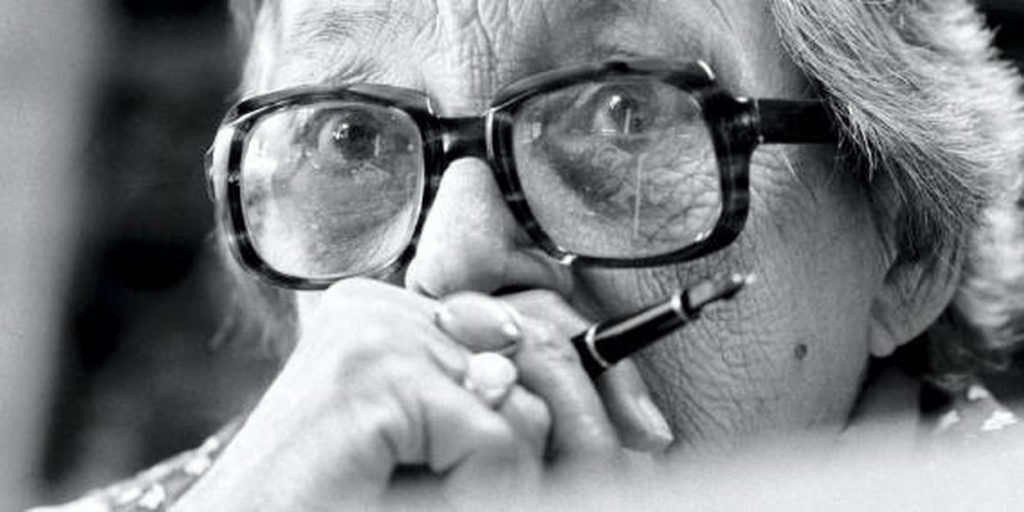Ce que traduire Duras veut dire
 Writing and translating could be described as sister arts. Writers become translators, and translators become writers. After all, what is writing but the translation of ideas, experience, and memory onto the page? As writer-translators, we might seek guidance and models to follow—a way out of the text to be translated, or a way through.
Writing and translating could be described as sister arts. Writers become translators, and translators become writers. After all, what is writing but the translation of ideas, experience, and memory onto the page? As writer-translators, we might seek guidance and models to follow—a way out of the text to be translated, or a way through.
One writer I turn to again and again to help navigate the complex threads tying together reading and writing—both so key to a sustainable translation practice—is Marguerite Duras, the celebrated French writer and experimental film-maker. Best known for The Lover (a hybrid work that is best described as fictionalised autobiography, which won the 1984 Prix Goncourt), her oeuvre is distinctive, addressing themes of desire, loss, and death, in a style that can be repetitive, sparse, but striking all the same.
Duras enjoys a certain infamy as a public figure in France—born in French Indochina (modern-day Vietnam) in 1914, she moved to her parents’ native France at aged seventeen. During World War II, she was a member of the Communist Party and of the French Resistance, alongside François Mitterrand (who later became President of France). Her husband was deported to Buchenwald, the notorious concentration camp—an experience she later drew on for her work The War. Later in life she was a notoriousfemme de lettres, known for her alcoholism and at times controversial opinions, as well as her literary success.
Duras never wrote directly about the art of translation, but her work does testify to an interest in foreign languages. Non-Francophone names populate her work, as in The Ravishing of Lol Stein, whose protagonist Lol V. Stein falls in love with Michael Richardson and frequents S. Thala and T. Beach. This interest in language as a tool and practice is evidenced in her essay on writing, Écrire, a reflexive piece that provides fruitful new ways of thinking about translation as a mode and as a discipline. It’s a piece full of contradictions—thought-provoking statements that lead us towards a Durassian conception of writing and style, which is in turn fruitful for our thinking about the arts of reading and writing, and their impact on translation.
In Écrire, Duras begins the text grounded in her material reality, that of the house where she writes her novels, and we might expect a fairly autobiographical piece on her writing process. But instead she flits between episodes of narration and meditative passages that analyse the curious and contradictory nature of writing. As in her fiction, her voice resists narration or diegesis, and instead attempts to analyse writing as a form and practice:
C’est curieux un écrivain. C’est une contradiction et aussi un non-sens. Écrire c’est aussi ne pas parler. C’est se taire. C’est hurler sans bruit.
It’s a curious thing, a writer. It’s a contradiction and also nonsense. Writing is also not speaking. It’s falling silent. It’s screaming noiselessly.
I say “attempts” not because Duras fails in characterising writing, but because her definition is inherently paradoxical and contradictory. She herself describes writing as a contradiction, as nonsense—and the French ‘non-sens’ really underscores the lack of sense, the lack of meaning at play.
It might seem strange to characterise writing as not speaking, as falling silent. But Duras chooses the reflexive “se taire” for silence, reminding us that silence—like speech—is not something passive, but is instead an active choice. Then writing itself can function by omission. It can live in the gaps between the letters and the things that go unsaid. Duras would have us remember the gaps between what is said and what is meant: between signifier and signified. She reminds us that language is a limited and limiting tool. And maybe that’s why we scream noiselessly—we’re dumbstruck, seeking language as a way out, even as language continues to fail us.
Nowhere is this more clear than in her fiction—silences, gaps, and holes populate her work. Things become conspicuous by their absence, and in absentia gain significance. The Lover, arguably her most famous work, exemplifies this. The book itself is said to have begun as an autobiographical project, with Duras the writer—and at this point, a famous public figure in France—looking over photos taken throughout her childhood in Indochina, present-day Vietnam. A simple enough endeavour, in theory.
But in Duras’ work, the truth is slippery. The book we encounter does in fact hinge on a photograph, but a non-existent one. There was to be a photograph of the young narrator on the ferry, crossing the Mekong river, but it was never taken, and gains value through its absence: “c’est à cette manque d’avoir été faite qu’elle doit sa vertu, celle de représenter un absolu, d’en être justement l’auteur” (it’s to this lack of being taken that [the photograph] owes its value, that of representing an absolute, of being precisely the author).
This image is not only important because of its potential subject matter—it also owes its value to its non-existence, thematising the presence of absence. This paradox, this hole at the heart of the work, drives the writing, haunting the narrative even when the narrator finishes recounting her first sexual experience: “déjà, sur le bac, avant son heure, l’image aurait participé de cet instant” (already, there on the bridge, before its time, the image would have begun from that instant).
This photograph becomes an impossibility in its all-encompassing range; it becomes a symbol of the attempt to capture an experience. By showing us an absent image, instead of offering direct narration, Duras allows the text to gesture towards a transcendental experience that cannot be specifically narrated.
The paradoxical status of this photograph reflects the paradoxical nature of writing, as highlighted in Écrire; the photograph in question cannot exist because it is impossible to capture desire, and this reflects the impossibility of writing certain kinds of experience—and of writing in general. The only way out that Duras offers appears to be writing about the impossibility of writing: highlighting gaps, silences, and absences that hint at the inexpressible.
The absent photograph at the heart of The Lover meets its conceptual twin in The Ravishing of Lol Stein, a novel in which our eponymous protagonist is forever transformed by her experience of being abandoned by her fiancé as a teenager—the titular “ravishing.” The narrator, Jacques Hold, becomes Lol’s lover, and is intrigued by the mystery of her past. In his attempts to talk about Lol, to understand her, our narrator coins the concept of a “mot-trou” to explain her silence, ingeniously translated as a “hole-word” by Richard Seaver, playing on the assonance of “hole” and “whole”:
Ç’aurait été un mot-absence, un mot-trou, creusé en son centre d’un trou, de ce trou où tous les autres mots auraient été enterrés
It would have been an absence-word, a hole-word, whose centre would have been hollowed out into a hole, the kind of hole in which all other words would have been buried (Richard Seaver’s translation)
This hole-word is an absence-word, a word made hollow, where “all the other words would be buried,” narrated in the conditional to remind us of its impossibility. After all, what the hole-word represents is all language, an infinity of language, so wide-reaching that it becomes unsayable. The narrator says it would be impossible to pronounce the “hole-word,” but it would reverberate all the same, an “empty gong.”
This metaphor has potential for thinking about translation as a mode, because it reminds us that some things are unsayable—or even untranslatable. This perfect hole-word is perfect by its very impossibility. If we take Duras’ conceit even further, we can apply it not just to language as an imperfect tool for writers, but to the idea of meaning in translation. Duras’ hole-word reminds me of a black hole, not as understood by a physicist, but from a literary perspective—a mass so dense and dark that it distorts all attempts to understand it, by consuming all light that might make it knowable. Like the hole-word, it’s dense and rich with matter and meaning, but impenetrable all the same.
In The Ravishing of Lol Stein, our narrator tells us that the hole-word ruins all other words, by reminding us of their incomplete nature—it contaminates them. But once we’ve realised the potential of such a concept, it does anything but ruin language—by reminding us of language’s limited nature, it gives us bounds for creativity. Duras has us running laps around the void that is a black hole. By focusing on the unsayable (or untranslatable), it becomes the invisible engine that drives the writing, a gravitational pull that spins us around and around on a quest for meaning.
In Écrire, Duras highlights the idea that writing is not a direct mode:
Ce n’est même pas une réflexion, écrire, c’est une sorte de faculté qu’on a à côté de sa personne, parallèlement à elle-même.
It’s not even a thought, writing, it’s a kind of faculty that one has next to one’s person, parallel to oneself.
She describes writing here not as a thought, but instead as a kind of faculty that exists outside of the writer, that runs alongside in parallel. It doesn’t intrinsically belong to the writer, but instead accompanies them. For Duras, then, writing is elliptical—constantly revolving around an absent meaning or truth at its centre, which is inherently unspeakable. Hers is an evasive mode of writing, where meaning is constructed via the gap between what is said and what happens. Writing is necessarily incomplete.
This is where the reader—or the reader-translator—comes in. Duras invites us to examine the fact that her works are necessarily incomplete, for her fiction is replete with references to gaps, absences, things that cannot be spoken, or things that are repeated and become distorted in their repetition, laying doubt to any claim on the truth. After all, as Duras examines in Écrire, writing is itself an impossibility.
But then, with all this gap-filling required of the reader, they are, in many ways, forced to become the writer of the text. The reader has to construct meaning in the abstract when language fails, even if as readers, we might struggle to verbalise this ourselves. This echoes the position of the translator, both diligent reader and agile writer, negotiating two imperfect languages in an attempt to find the truth—or truths—at the centre.
The Durassian mode of writing, then, is fruitful for translation. Acknowledging the existence of the hole-word doesn’t ruin translation, but simply reminds us of the constraints that exist when navigating between two different languages. Just as Duras works through and makes productive use of the gaps between language and meaning, so can we exploit the gaps between two different languages. That’s the skill in writing as interpretation—the acknowledgement that a translation will differ from its mother text is necessary, but translators are able to thrive under that constraint. After all, if the text we’re translating is striving towards something unspeakable in its original language, who’s to say that the target language can’t help us closer to untangling this, in some respects?
Duras depicts the relationship between writing and what’s trying to be written as a constant negotiation, one that might be beyond our control—especially if writing is a faculty outside of ourselves. Translation, too, is a negotiation—sacrificing some aspects for others, be that style, sound, readability, all in pursuit of a translation that feels true to us, as readers—and as writers.
Another way in which Duras provides a useful framework for looking at translation is through her acknowledgement of the art of reading, and the intrinsic importance of the reader-writer relationship, which translators fully inhabit. As post-modern literary theory teaches us, readers make the text by reading it. Roland Barthes’ famous proclamation of the ‘death of the author’ directly connects it to the birth of the reader, or to put it simply, as Duras does:
Et lire c’était écrire.
And reading was writing.
The process of translation encourages an active reading of the text, which itself becomes a form of writing. The reader has to take an active role, almost in dialogue with the written text on the page—and as they fill gaps and uncover meanings, they write the text, for themselves. Translators then take one step further, in transcribing that joint process of reading and writing simultaneously, and in a new language.
There is one dark cloud hovering above the idea of translation as a Durassian mode: failure. Just as the hole-word’s existence contaminates all other language, in Écrire, Duras directly addresses impossibility:
Écrire.
Je ne peux pas.
Personne ne peut.Writing.
I can’t do it.
No one can.
Elsewhere, she even tells us that writing is untenable. But should this make translation as a practice untenable?
I don’t think so. Translation might be impossible, but that doesn’t make it untenable, or unproductive. Its impossibility comes down to the abstract nature of meaning, a loaded term that’s worth unpacking. For a translation to be “perfect,” we might say that it has to perfectly capture the meaning of a text. But that’s a risky assumption, on several counts: it assumes we have perfectly understood the meaning of a text—that we are perfect readers; that all meanings are expressible in language; and that there’s one hegemonic meaning to a text.
In that sense, the project of a “perfect” translation is doomed to fail. But Duras’ writing is testament to the fact that failure itself is part of the project, and acknowledging that truth makes her work richer and more impactful. After all, her body of work constantly thematises unsayable experiences—desire, death, and loss, such as in her literary and cinematic works that look at the horrors of the Holocaust and Hiroshima. It would be incongruous to narrate these without acknowledging the impossibility of putting language to these kinds of experiences. So Duras uses devices—be it the absent photograph or the hole-word—to write the paradox of writing into the text itself. In works that focus on and thematise unsayable experiences, the text allows for them to remain true to their nature, to remain unsayable. It would be unethical to pretend that there was an easy way out.
It’s powerful, though, to acknowledge the possibility of failure, and to try anyway. And in a world where the English language is so dominant, there’s a moral imperative to commit to the project of translation even when it feels impossible, and to dismantle linguistic borders and invented boundaries—translation is a vital tool for writers to find new readers, and for readers to explore new worlds.
So as translators, what can we do? In Duras’ words:
Il faut le dire : on ne peut pas.
Et on écrit.You must say it: you cannot.
And you write.
And we translate. The risk of not making the attempt is too great.
Georgina Fooks
(writer and translator, and is Social Media Manager at Asymptote. She studied French and Spanish literature at Oxford and is currently preparing for postgraduate study, specialising in Argentine poetry. She has lived in Santiago and Paris, and currently works in London).
Article publié sur la revue numérique de traduction Asymptote
3 Réponses pour Ce que traduire Duras veut dire
I feel so grateful to read this clever feedback about Duras’s writings, which requires from her readers a full attention.
Just like for those who attempt to listen, and not just hear, the song of Kafka’s Josefine.
Just like these physicists who attempt to get a cosmic fact, or oddity, not from a direct sight, but get it, for sure, through sounds and effects it produces.
Great, I love this sister in ellipse art.
Beau texte.belle compréhension et analyse de Duras.
I fully agree with the last sentence though I have my reservations re the translation of « bac » by « bridge » – « un bac » is a ferry, isn’t it?


3
commentaires